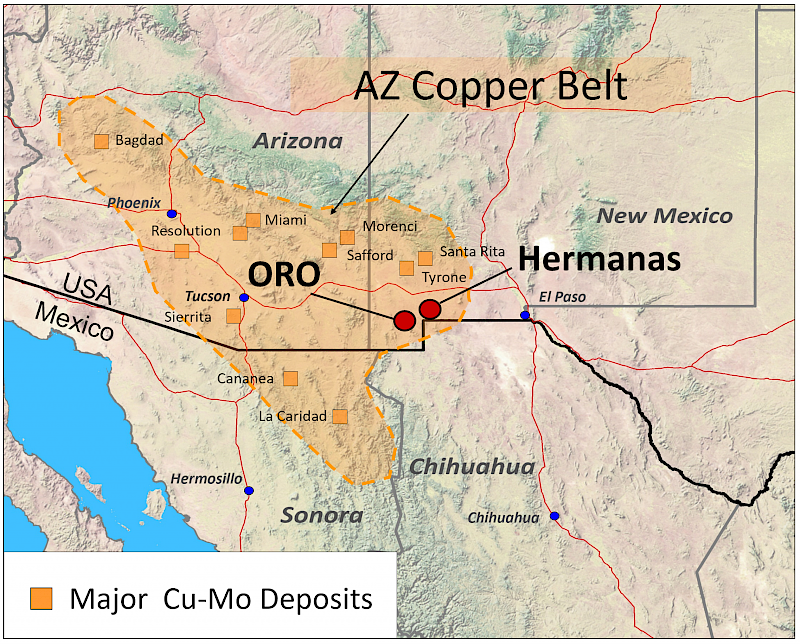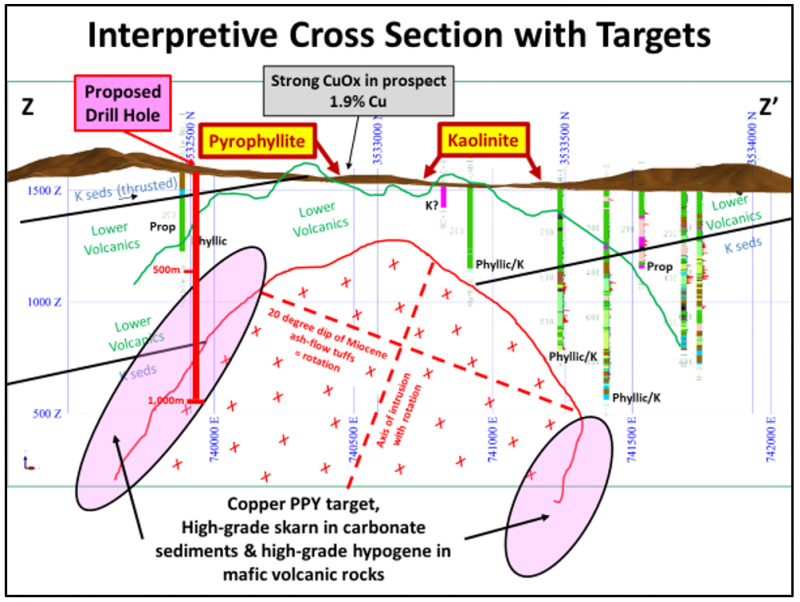The 2,700-hectare Oro property consists of eight patented mining claims and 334 BLM-administered Federal lode mining claims, covering the majority of the historic Eureka Mining District in Grant County, New Mexico.

Several historic mines within the Eureka Mining District produced copper, lead, zinc, silver, and gold from the amalgamated property which covers a large, well-zoned Laramide-age mineral system consisting of an unexposed Cu-Mo porphyry system, flanked by a ring of Ag-Pb-Zn Carbonate Replacement Deposits (CRDs) and distal disseminated Au occurrences outboard of the replacement deposits. Current exploration on the property is focused on the discovery and development of world-class Cu-Mo porphyry and replacement deposits.
Targeting for copper mineralization (see Interpretive Cross Section) is based upon 3D modelling of data generated by geologic mapping, historic drill holes, geochemical zoning studies, alteration clay zoning studies, and airborne geophysical surveys. A 4-hole (4,050 metre) diamond drill program commenced in early-2022 and is now complete. Drilling to date has successfully identified:
- Classic geochemical and alteration zoning demonstrating near-surface “lithocap” and low temperature propylitic alteration transitioning at depth into a thick zone of strong pyritic-enriched/phyllic-alteration, and at further depth transitioning into higher temperature potassic alteration with strong copper enrichment;
- Increasing molybdenite concentrations with depth within the potassic alteration, suggesting the strongest copper mineralization lies deeper in the hydrothermal system; and
- Unexposed hydrothermal diatreme breccias with copper oxides directly beneath gravel cover in two holes, a potential host for high-grade copper at depth.
Although assays are pending for two holes, results from these initial four holes provide the company with a better understanding of the underlying stratigraphy, the distribution of the main alteration phases and, importantly, the relationship between the previously acquired ZTEM geophysical signatures and the alteration assemblages to enhance further drill targeting within this 6km2 area.
Commenting on these recent results, President Lawrence Page K.C. said, “Oro is a large, well-zoned mineral system situated along a major regional trend containing world-class copper deposits and mines extending from southwestern New Mexico into eastern Arizona. Verification of classic copper porphyry metal zoning in these initial four core holes is very encouraging. Our interpretations from this most recent drilling and earlier work suggests that the entire hydrothermal system is preserved beneath a tilted clay-rich Lithocap leaving tremendous opportunities for the discovery of significant new Cu-Mo deposits both at depth and in related high-grade structures throughout the property.”

Oro Project – Other Targets
Surrounding the CRD zone are distal-disseminated, sediment-hosted, gold showings, such as at the Stockpond target, where the Company has conducted limited exploratory drilling. The drilling encountered strongly oxidized, disseminated gold mineralization beneath shallow gravel cover that was limited by a post-mineral fault that buried potential extensions beneath much thicker gravel, but which remains open for further exploration.
Southern Silver expanded the property in late 2021 by staking 40 new unpatented lode claims over a gold + copper geochemical anomaly in soils along the projection of the distal-disseminated gold zone under overburden south of the Stockpond target. Gravity geophysics indicates that the gravel is shallow in this area, which has never been tested by drilling.
Eureka Mining District – Early History
The Eureka Mining District was created in 1877 after the discovery of lead, copper, and silver. By 1880, several high-grade base and precious metal mines were in operation in the district but were only mined intermittently due to hostile local inhabitants and fluctuating silver prices.
Production began at the Oro Project shortly after the metals were discovered and continued sporadically through the early 1960’s. The New Mexico Bureau of Mines estimates production from the Eureka District between 1880 and 1961 at 2.9 million pounds of lead, 1.7 million pounds of zinc, 0.5 million pounds of copper, 0.45 million ounces of silver and 5,000 ounces of gold. Reported grades are in the range of 20 oz/ton (685 g/t) Ag, 4% combined Zn and Pb, and up to 0.04 oz/ton (1.4g/t) Au. Smaller amounts of high-grade mineralization were reported to have assayed up to 5.5% Cu and 840 oz/ton Ag.
The early phase of mining in the Eureka Mining District lasted until the 1920s, when a decrease in metal prices made the mines uneconomic. Limited work has been done in the region since then, with the most recent records of exploration and mining dating to the early 1960s when several companies recognized the potential for a large porphyry copper deposit. Historic records indicate that low metal prices were again responsible for the cessation of mining activity in the area in 1960, and that untested targets remain in the vicinity of the old mine workings, particularly at the American Mine, now part of the Oro claim group.
